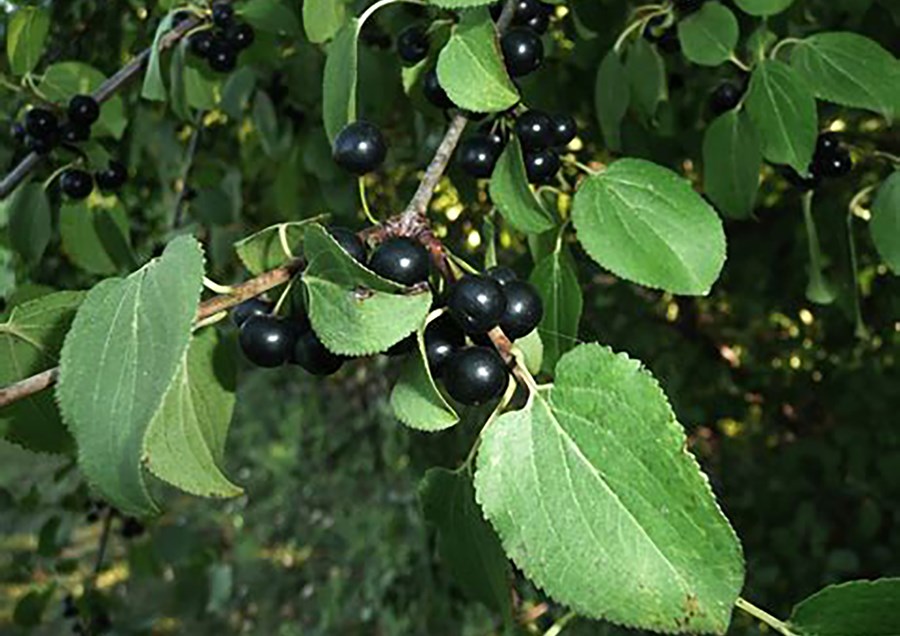There was a time when land managers promoted the planting of European buckthorn, rhamnus cathartica, along roadsides and in the windrows between fields.
The shrubby tree could reach a height of up to seven metres, was fast growing, and could survive in a wide range of habitats. It was shade-tolerant, drought-tolerant, and produced an abundant supply of fruit for wildlife. It seemed like the perfect choice.
But those were the days before environmental awareness, before it became apparent that introduced species like buckthorn, freed from competitive constraints and the insect predators of their native lands, could out-compete native species here, and become invasive.
As Paul Cottenden, forest technician with the Lake Simcoe Region Conservation Authority noted, “It takes time for us to learn some of its negative impacts.”
Introduced by gardeners in the 1880s, and then widely used for windbreaks and erosion control, buckthorn has spread aggressively. It has invaded roadsides, riverbanks, mature forests, and farm fields, forming dense stands and reducing biodiversity.
Its abundant fruit make it easy for the fast-germinating seeds to be widely disseminated, in the droppings of birds and other animals.
The fruits have an even sneakier trick to ensure spread: They act as a laxative, causing wildlife to quickly deliver the seeds into the environment.
“It’s a really interesting plant,” said Cottenden. “It’s very shade tolerant, and it’s very drought resistant. Those two factors together — it’s pre-adapted for climate change.”
And with a range of strategies that give it an advantage — the laxative qualities of the fruit, the fact that the seed takes only 28 days to germinate, that it’s one of the first shrubs to send out leaves in the spring and the last to drop them in the fall.
“It’s just how it’s evolved to make sure we don’t eliminate it. It’s so adapted for being here for the long haul,” he said.
Buckthorn is also suspected of altering the chemical composition of the soil, leading to long-term changes that may discourage re-vegetation by native species, even after the invader is removed, and encourage the invasive earthworms that destroy leaf litter. In hardwood forests, that can prevent the regeneration of the native forest understory.
More critically for agriculture, buckthorn was found to host diseases and insects that can impact crop yields. Buckthorn is a host for the fungus, oat crown rust – affecting the yield and quality of oats. It is also important to the over-winter survival of the soybean aphid, a serious pest of soy crops.
In fact, the proliferation of buckthorn resulted in a proliferation of the aphids, leading to biological control attempts using introduced ladybugs - which may have led to a decline in the numbers of native ladybug species.
It’s clear that the impacts of buckthorn are complex, and far-reaching. Ontario’s Weed Control Act now lists buckthorn as a “noxious weed,” leading to efforts to remove it wherever it is found, especially along roads and fields. Under the legislation, landowners are responsible for its removal.
Easier said than done: the deep roots are difficult to pull up. Not only can the shrub reach a height of seven metres, it can achieve a diameter of up to 25 centimetres.
Small plants up to three centimetres can easily be pulled up on lighter soils, said Cottenden. “It’s a very viable option when it’s smaller.”
For larger plants, while the Ministry of Natural Resources and Forestry recommends a “weed wrench.”
Cottenden warned: “You can do it, but it’s a lot of work,” and suggested “bringing in an expert.” The worst thing to do is cut down buckthorn. “It just causes suckering.”
Instead, Cottenden recommended girdling larger stems — creating a cut all the way around, through the cambium that underlies the bark, to weaken and kill the plant, although it may take several years.
But wear gloves, eye protection and other protective clothing, he said. Buckthorn has smooth dark green leaves, finely toothed along the edges, arranged in opposite or nearly opposite pairs along the stem, each of which ends in a short, sharp spine.
Homeowners should also take care to collect the berries, which otherwise can germinate — and can remain viable in the soil for up to five years. The clusters of blackberry-like fruit ripen in late summer and fall, and can be the last berries available in winter for wildlife.
“Bottom line, the birds love it, and the berries stay on for a long time,” Cottenden said. “They brought Buckthorn here, hoping for some positives. It’s really adapted and evolved, to say, ‘I’m staying here for the long haul.’
“When I look around, I’ve seen it everywhere.”
Don’t plant it, don’t compost it — and if you see it, report it to the Invading Species Hotline at 1-800-563-7711, or EDDMapS Ontario.



